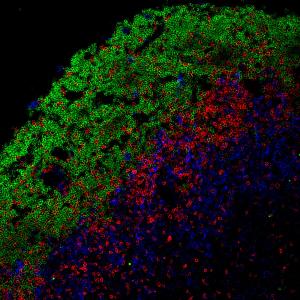How B and T cells fuel the pathological process in MS
25 Apr 2025
Researchers at LMU have deciphered immunological mechanisms in so-called ectopic lymphoid follicle-like structures in multiple sclerosis (MS).
25 Apr 2025
Researchers at LMU have deciphered immunological mechanisms in so-called ectopic lymphoid follicle-like structures in multiple sclerosis (MS).

Accumulation of immune cells: B cells (green) and T cells (red) | © Peters Group
Some 280,000 to 300,000 people in Germany live with multiple sclerosis (MS) – and the trend is increasing. In this chronic inflammatory autoimmune disease, the body’s own immune system typically attacks the protective layer of nerve fibers known as the myelin sheath.
In many MS patients, large accumulations of immune cells, particularly B and T cells, form under the meninges. These ectopic lymphoid follicle-like structures (eLFs) are cellular aggregations of the immune system that form outside of the classic lymphoid organs like lymph nodes and spleen.
“The function of these meningeal follicles was previously unclear,” says Dr. Anneli Peters from the Biomedical Center Munich, Institute of Clinical Neuroimmunology, at LMU. “In our model, we were able to demonstrate that B and T cells cooperate intensively in these structures, which leads to the maturation and activation of autoreactive immune cells.” The new study thus furnishes initial evidence that the meningeal follicles could continuously fuel inflammatory processes in the central nervous system. The researchers have published their findings in the journal Science Immunology.
Regarding the background: medical doctors are familiar with eLFs from tumors, where they play a role in defense against cancer cells. However, it is not known why these structures also form in the brain and spinal cord of people with severe MS.
One reason for the lack of knowledge is that the presence of eLFs can usually only be ascertained in the context of postmortal histopathological examinations. This makes it difficult to capture and understand their exact function and development in MS.
Using a mouse model, researchers led by Anneli Peters managed to obtain important insights. They transferred special T helper cells, which recognize the myelin oligodendrocyte glycoprotein (MOG) and were previously differentiated in vitro into interleukin-17-producing Th17 cells, into immunocompetent mice. MOG is a protein of the myelin sheath of nerve cells. In this way, the researchers induced experimental autoimmune encephalomyelitis, an MS-like disease in which eLFs form, in the mice.
“By means of high-resolution live imaging, we managed to demonstrate direct and long-lasting contacts between Th17 T cells and B cells in the eLFs,” says Peters. This interaction led to the reactivation of autoreactive T cells – a process that further drives chronic inflammation in the central nervous system (CNS).
T cells and B cells are connected to each other in a sort of reciprocal dependency: T cells in the CNS need the support of B cells to sustain a pro-inflammatory cytokine profile. Conversely, T cells promote the differentiation and proliferation of B cells – a reciprocal stimulation that maintains smoldering inflammation in the CNS.
Interestingly, the origins of eLFs lie in highly activated B cells that migrate to the CNS. “We observed that under Th17 cell stimulation, B cells in the eLFs begin to initiate maturation processes and undergo clonal expansion – they react to the signals of the T cells,” explains Peters. Even if B cells migrate to the CNS later than Th17 cells, they can reactivate autoreactive T cells there and amplify their inflammatory function via antigen presentation.

Dr. Anneli Peters researches mechanisms of immune cell activation. | © Jan Greune / LMU
The discovery that T and B cells cooperate closely in eLFs and amplify each other’s activity opens up new therapeutic possibilities. “Our results suggest that this codependency could be a highly promising target for new treatment approaches for autoimmune diseases like multiple sclerosis,” remarks Peters.
Follow-up studies are underway. “We would like to research the precise mechanism of immune cell activation in the meningeal follicles and understand which signaling pathways are important for the formation of these structures,” explains the scientist. “In addition, we’re very eager to investigate the extent to which the results from our model are translatable to MS patients.”
Anna Kolz, Clara de la Rosa, Isabel J. Syma, Sarah McGrath, Vladyslav Kavaka, Rosa Schmitz, Anna S. Thomann, Martin Kerschensteiner, Eduardo Beltran, Naoto Kawakami, Anneli Peters: T-B cell cooperation in ectopic lymphoid follicles propagates CNS autoimmunity. Science Immunology, 2025